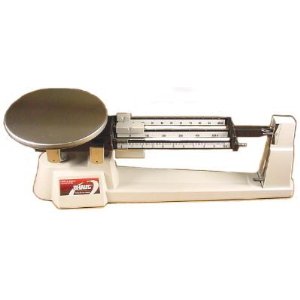How do I do a test swatch before I commit to dyeing 7 yards of fabric?
Name: Julie
—ADVERTISEMENTS—

Ohaus Mechanical Triple Beam Balance
Ohaus 750-SO Mechanical Triple Beam Balance Scale. Capacity: 610 grams x 0.1 gram

Escali L125 L-Series Professional Lab Scale
Capacity 125 gram; resolution 0.01 gram. Six units of measure: Grams, Ounces, Grains, Carats, Pennyweights and Troy-ounces.
Country or region: Canada
Message: How do I do a test swatch before I commit to dyeing 7 yards of fabric? I'm planning to cut a 8" x 8" swatch to test the color out. Do I use 1/2 tsp per 1 cup of water? Might be using Dharma Procion dye. New dyer.
You'll need to weigh both your fabric and your dye. Take the same fraction of everything: for example, if your 7 yards of fabric weigh a total of 1400 grams (that's three pounds), then you could try dyeing a test swatch that weighs 14 grams; since that's 1/100th of the total, you would also use 1/100th as much dye, 1/100th as much water, and 1/100th as much of any auxiliary chemicals. Of course it doesn't have to be exactly 1/100th, as long as you scale everything down by the same factor, but 1/100th makes for some easy math.
Be sure that the water is the same temperature for your test as it will be in your full-scale dyeing, and that the amount of time for each step in your dyeing recipe is the same.
If you would normally dye your large amount of fabric in a twenty-gallon top-loading washing machine, you can do your 1/100th scale test in 0.75 liters of water, in a one-quart container, stirring frequently with a glass, plastic, or stainless steel spoon.
For a tiny amount of dye, it may be difficult to weigh out a sufficiently small amount. If your scale will only weigh in increments of 0.5 g, for example, you don't want to weigh out a quantity smaller than ten times that amount, for the sake of precision. Unfortunately, scales that are precise to much smaller increments are more expensive. The answer is to make up stock solutions to work with, as described for acid dyes in this earlier post: "How can I measure the right amount of acid dye to use for a particular color?".
It's not impossible to scale up or down while measuring dyes and chemicals by volume, rather than weight, but, since different dye lots are standardized by weight, rather than volume, the results you get now will not be usable for a different jar of dye a few years from now. Also, the math is much more difficult if you use measuring spoons with common measurements, rather than a gram scale plus graduated cylinders and pipettes with the metric system.
In the US, if measuring spoons and cups are very accurate, then one teaspoon equals 5 milliliters (ml), one tablespoon equals 15 ml, and one cup equals 16 tablespoons, or 240 ml. Sources vary over the equivalence for Canadian measuring spoons. I've seen one chart that indicated that a tablespoon in Canada is 14 ml, and a teaspoon 4.7 ml, but in another chart, a teaspoon was listed as 5 ml while a tablespoon was listed as containing 20 ml, and one cup, 250 ml. You'd better check this, in any case, because kitchen measuring spoons are notorious for inaccuracy. Check your own measuring spoons if you're using them, to see whether three teaspoons is indeed equal to one tablespoon, or one cup to sixteen tablespoons.
You will need an accurate kitchen scale to weigh your test fabric to make sure that it is the right size, as converting between weights and yardages is impractical without one.
(Please help support this web site. Thank you.)
Posted: Friday - May 06, 2011 at 08:59 AM
Follow this blog on twitter here.
Quick Links
- All About Dyes & Dyeing Top -
- Top of this blog -
- FAQ -
- The Dye Forum -
- How to Tie Dye - How to Batik -
- Books - Toys - Plants -
- Top of this blog -
- FAQ -
- The Dye Forum -
- How to Tie Dye - How to Batik -
- Books - Toys - Plants -
More in this category:
- -
Statistics
Total entries in this blog:
Total entries in this category:
Published On: Aug 29, 2012 02:49 PM
Total entries in this category:
Published On: Aug 29, 2012 02:49 PM